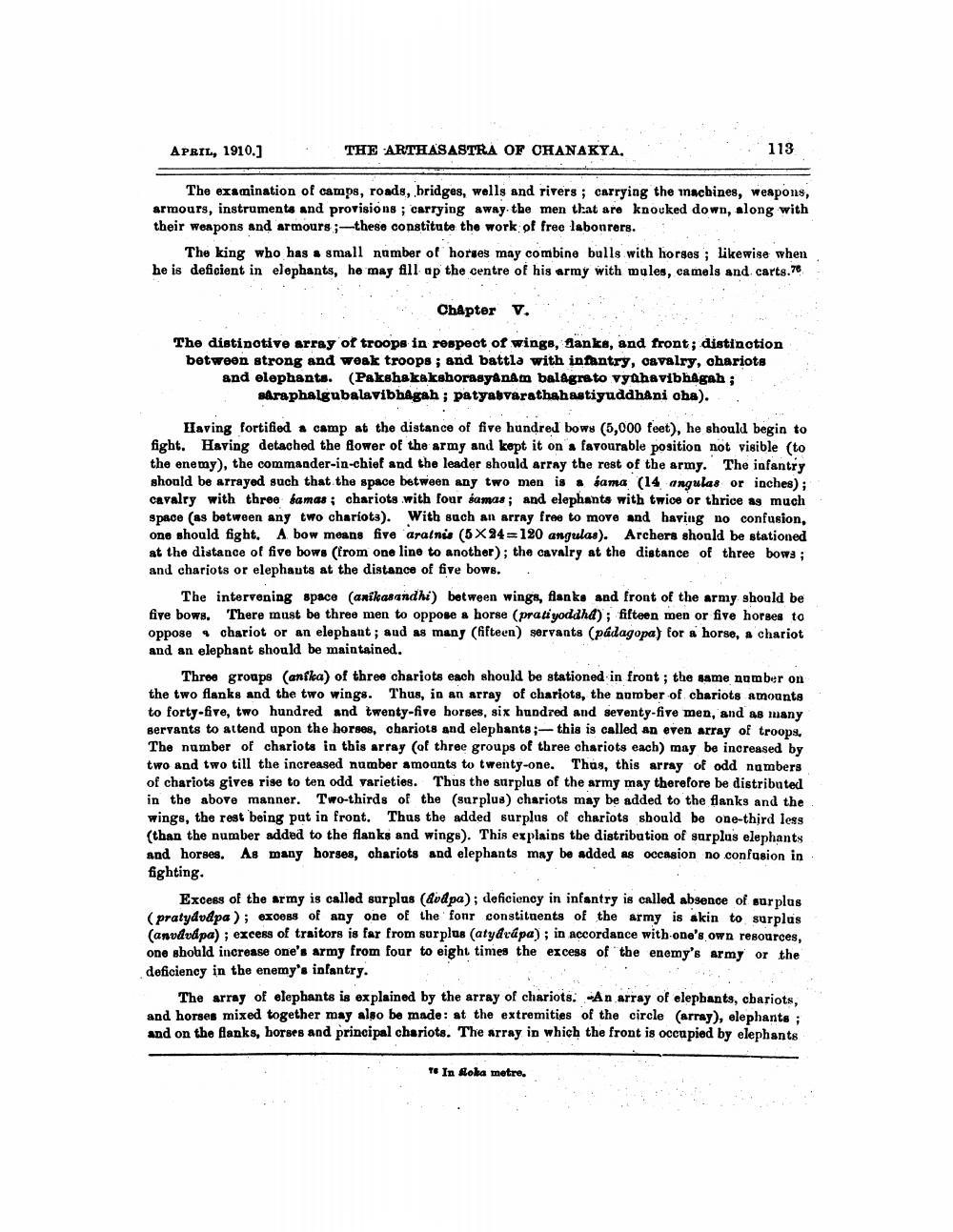________________
APRIL, 1910.]
THE ARTHASASTRA OF CHANAKYA.
.
113
14.
The examination of camps, roads, bridges, wells and rivers ; carrying the machines, weapons, armours, instruments and provisions ; carrying away. the men that are knocked down, along with their weapons and armours ;-these constitute the work of free labonrers.
The king who has a small number of horses may combine bulls with horges; Likewise when he is deficient in elephants, he may fill ap the centre of his army with mules, camels and carts.76
Chapter
V.
. .
The distinctive array of troops in respect of wings, Aanks, and front; distinction between strong and weak troops; and battla with infantry, cavalry, ohariots and elephants. (Pakshakakahorasyanam balagreto vydhavibhagah;
AraphalgubalavibhAgah ; patyalvarathahastiyuddhani oba).
Having fortified a camp at the distance of five hundred bow (5,000 feet), he should begin to fight. Having detached the flower of the army and kept it on a favourable position not visible to the enemy), the commander-in-chief and the leader should array the rest of the army. The infantry should be arrayed such that the space between any two men is . sama (14 angulas or inches); cavalry with three samas ; chariots with four samas; and elephants with twice or thrice as much space (as between any two chariota). With such an array free to move and having no confusion, one should fight. A bow means five aratnis (5 X 24=120 angulas). Archers should be stationed at the distance of five bows (from one line to another); the cavalry at the distance of three bows; and chariots or elephauts at the distance of five bows. .
The intervening space (anikasandhi) between wings, flanks and front of the army should be five bows. There must be three men to oppose a horse (prati yoddhd); fifteen men or five horses to oppose , chariot or an elephant; aud as many (fifteen) servants (padagopa) for a horse, a chariot and an elephant should be maintained.
Three groups (anska) of three chariots each should be stationed in front; the same number on the two flanks and the two wings. Thus, in an array of chariots, the number of chariots amounts to forty-five, two hundred and twenty-five horses, six hundred and seventy-five men, and as many servants to attend upon the horses, chariots and elephants;- this is called an even array of troops The number of chariots in this array of three groups of three chariots each) may be increased by two and two till the increased number amounts to twenty-one. Thus, this array of odd numbers of chariots gives rise to ten odd varieties. Thus the surplus of the army may therefore be distributed in the above manner. Two-thirds of the (surplus) chariots may be added to the flanks and the wings, the rest being put in front. Thus the added surplus of chariots should be one-third less (than the number added to the flanks and wings). This explains the distribution of surplus elephants and horses. As many horses, chariots and elephants may be added as occasion no confqsion in fighting
Excess of the army is called surplus (dvdpa); deficiency in infantry is called absence of surplus (pratydvdpa); excess of any one of the font constituents of the army is akin to surplus (anvdvdpa); excess of traitors is far from surplus (atydrápa); in accordance with one's own resources, one should increase one's army from four to eight times the excess of the enemy's army or the deficiency in the enemy's infantry.
The array of elephants is explained by the array of chariots. -An array of elephants, cbariots, and horses mixed together may also be made: at the extremities of the circle (array), elephants ; and on the flanks, horses and principal chariots. The array in which the front is occupied by elephants
T# In Roka metre.




